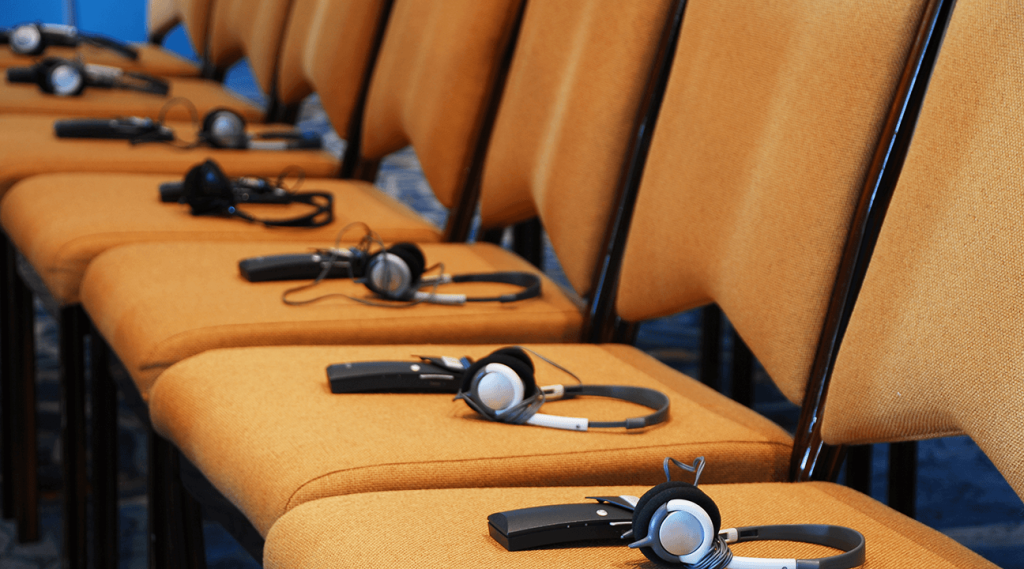Here at Creative Word, we’ve been providing clients with professional interpreting services for almost twenty years, so we’re often asked for our advice regarding types of interpreting equipment for multilingual conferences.
In order to help our clients and ensure they receive not only the best language services, but also the best interpreting equipment, we have collated the following useful information which can be referred to time and again…
Organizing a Multilingual Conference
Organizing a multilingual conference can be time consuming and for the best results you will require professional interpreters and equipment.
Preparation is key to any successful event so if this is the first multilingual conference you’ve organized then it is worth checking out some of our previous blogs on the topic to give yourself a head-start and the best chance of success.
As a brief outline, you’ll need to consider the following points:
• Venue – can it handle the number of attendees alongside the required interpreters and equipment?
• Languages – which languages are you planning on providing?
• Interpreting – what type of interpreting will you offer on the day – consecutive or simultaneous? The choices you make will affect the type of equipment you’ll require and your choice of interpretation will depend upon your event.
• Language Service Provider (LSP) – choose your LSP well in advance of your event and check they offer reliable, native-speaking linguists
• Supporting documents – your interpreters will work best when given as much information as possible about the event. Offer bios of key speakers, industry information, notes, supporting materials, presentations, speeches, and the day’s schedule well in advance of the day.
• Equipment – read on to find out more…
Interpreting Equipment for Multilingual Conferences
Most large multilingual conferences or events offer simultaneous interpreting as it means the audience can hear in real-time and keynote speakers aren’t pausing at the end of every sentence for their words to be interpreted as when using consecutive interpreting.
Simultaneous interpreting requires the use of soundproofed translation booths for interpreters which contain microphones, alongside headsets for the audience.
A quality sound system is essential for the enjoyment of your audience and for ease for your interpreters and speakers.
Most large-scale events require some, or all, of the following interpreting equipment:
• Interpreting Booths – these are soundproofed booths where the interpreter works. They are fitted with everything the interpreter will require in order for them to provide a quality interpretation for your multilingual event. The booths are usually sited at the back of the conference so that they can see the speaker, but they aren’t a distraction for the audience. Booths are generally portable and can accommodate between one and four interpreters.
• Headsets – nowadays, these are usually wireless and offer multichannel options depending upon the language required by the audience. These tend to work using digital, infrared, wireless receivers, giving a quality connection, with comfortable headsets for the audience.
• Microphones – these transmit the words from the interpreter to the audience and are generally wireless. They allow the interpreter to maintain the natural flow of conversation and can be used with multiple languages.
• Remote Interpreting equipment – this has become more common since the Covid pandemic as it allows an event to take place virtually. This is useful when speakers or audiences are unable to travel, or for business meetings with participants placed in different locations around the world. Often used in conjunction with a video calling platform, the interpreting equipment allows the interpreter to serve as a third party, connecting speakers and listeners no matter where they are located.
However, if your event is small and intimate, it may not require everything in the above list.
Similarly, if your budget is limited there are different options worth considering such as, translating speaker’s scripts for your audience, offering subtitles for presentations, or using a single interpreter (offering simultaneous or consecutive interpreting) if you only require one additional language.
Interpreting tools and equipment are always changing in line with technological advances and there is a solution to every language problem.
We are always happy to discuss your personal requirements and can adapt to our client’s needs in most interpreting settings.
Contact us now to find out how we can support your multilingual event.












